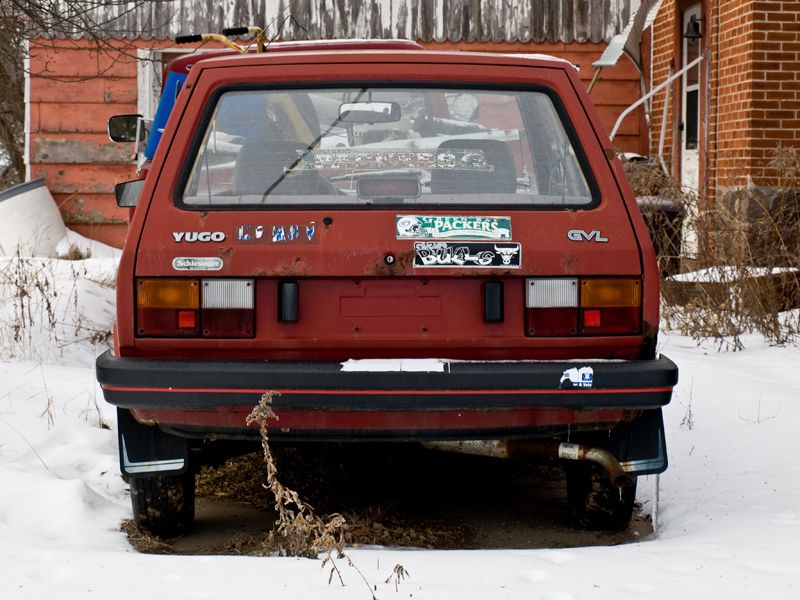Ako kupiš Yugo, nećeš vozit dugo, says a famous piece of Croatian folk wisdom - if you buy a Yugo, you won't be driving it for long.
The Yugo in question is the iconic car manufactured from 1977 to 2008 in the Serbian city of Kragujevac; the other part of the saying above refers to its questionable quality which led to the unfortunate reputation of the worst car in history. Car Talk declared the Yugo to be one of the worst cars of the millennium, TIME featured the Yugo GV on the '50 Worst Cars of All Time' list, and Complex Magazine awarded the Yugo 45 the first place on the '50 Worst Cars of the 80s' list. That's a lot of worsts. Poor Yugo.
The brand saw close to 795.000 cars produced in its 30-year lifespan, with 250.000 exported to foreign countries. Even though the public has always been united in their opinion of the legendary vehicle, the Yugo was a popular choice in all parts of the former Yugoslav territory, and spotting one on the street is not a rare sight even in the present day. (Here's another piece of folk wisdom, courtesy of my grandpa: if you see a Yugo on the road, be cautious - it's either driven by an 18-year-old or an 80-year-old, and none of the two are known for extraordinary driving skills.)
The Yugo was apparently so bad, its deplorable features served as inspiration for an entire book. Here's a list of 10 facts about the extinct brand, featured in Jason Vuic's book 'The Yugo: The Rise and Fall of the Worst Car in History' and selected by Večernji list on January 13, 2018.

1. While the car did rise to fame (or should we say notoriety) as the Yugo, its original name was actually Zastava 102. Also known as the Zastava Koral, the Yugo was a product of the biggest car manufacturer in Yugoslavia named Zastava Automobiles.
2. Even though the name would logically lead one to believe the Yugo was named after its country of origin, Vuic claims it was named after the southern wind jugo. Some evidence to support the fact: the first version of the name was spelled Jugo, later getting changed to Yugo so the brand would seem more approachable to the international market.
3. The Yugo was produced in Serbia, but it first took shape in Italy: the car was designed by Fiat and Zastava engineers in 1977, in Fiat's design centre in Turin. The Yugo was modeled after the famous Fiat 127 which was declared the European Car of the Year in 1972.
4. Mass production of the Yugo was set in motion in 1980 on Friday, November 28. The date was intentionally chosen so the first vehicle would get completed on November 29, the former Day of the Republic.

5. The Yugo had its US premiere in 1987, owing to the founder of International Automobile Importers Malcolm Bricklin. The fame was short-lived, though, as the United Nations sanctions had Zastava withdraw the Yugo from all export markets in the early 90s.
6. Speaking of the US, certain American politicians opposed the import of the vehicle from Yugoslavia, claiming its low price could be seen as dumping on the American market. Some have even accused Zastava of using slave labour; CEO of Yugo America Bill Prior denied the accusation by saying "they're not using slave labour, but Slav labour".
7. The Yugo might have been unpopular in the US, but at least one American favoured the Yugoslav brand. John Scanlan, a former US ambassador to Yugoslavia, went about his official business in Belgrade in a yellow Yugo.

8. The Yugo didn't exactly pass the crash tests in the US with flying colours, but it had better results than the Subaru GL in the category of driving safety and the Saab 900 in the category of passenger safety.
9. According to Toma Savić, one of Zastava's managers, two Yugo prototypes were gifted to Josip Broz Tito. Nobody knows whether Tito used the cars or not, but he previously gifted a Zastava 101 to Leonid Brezhnev.
10. Apart from being known as the Zastava Koral and the Yugo, the notorious car was also branded as Innocenti Koral, after the Italian machinery works known for manufacturing the Italian version of the famous Mini.


